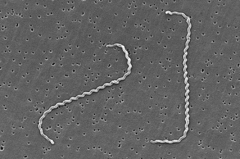Leptospira interrogans
Leptospira interrogans is a Gram negative, obligate aerobe spirochete, with periplasmic flagella. When viewed through a dark-field microscope, it often resembles a question mark, and this gives the species its name. It is a member of the genus Leptospira. Some important pathogenic serovars from this species are Canicola, Icterohaemorrhagiae and Australis. L. interrogans is difficult to culture, requiring special media and extended incubation periods.[1]
| Leptospira | |
|---|---|
 | |
| Scanning electron micrograph of Leptospira interrogans. | |
| Scientific classification | |
| Kingdom: | Eubacteria |
| Phylum: | |
| Class: | |
| Order: | |
| Family: | |
| Genus: | |
| Species: | L. interrogans |
L. interrogans infects wild and domestic animals, including pet dogs. Humans are accidental hosts. It can survive in neutral or slightly alkaline water for 3 months or longer.[1][2]
L. interrogans is usually transmitted to humans through contact with infected animal urine, either directly or in water. It invades directly through broken skin and can replicate in the liver and kidneys. Risk factors for infection include working in sewers, farming, and recreational water activities. Infection is known as leptospirosis, which can be asymptomatic, a mild non-specific illness, or result in death from liver damage and renal failure (Weil's syndrome).[1]
References
- Black, Jacquelyn G. (2005). Microbiology: Principles & Explorations (6th ed.). Hoboken, NJ: John Wiley & Sons. pp. 583–584. ISBN 0-471-42084-0.
- Ren SX, Fu G, Jiang XG, et al. (April 2003). "Unique physiological and pathogenic features of Leptospira interrogans revealed by whole-genome sequencing". Nature. 422 (6934): 888–93. doi:10.1038/nature01597. PMID 12712204.
External links
- https://www.ncbi.nlm.nih.gov/Taxonomy/Browser/wwwtax.cgi?id=173
- Leptospira protein abundances
- Type strain of Leptospira interrogans at BacDive - the Bacterial Diversity Metadatabase